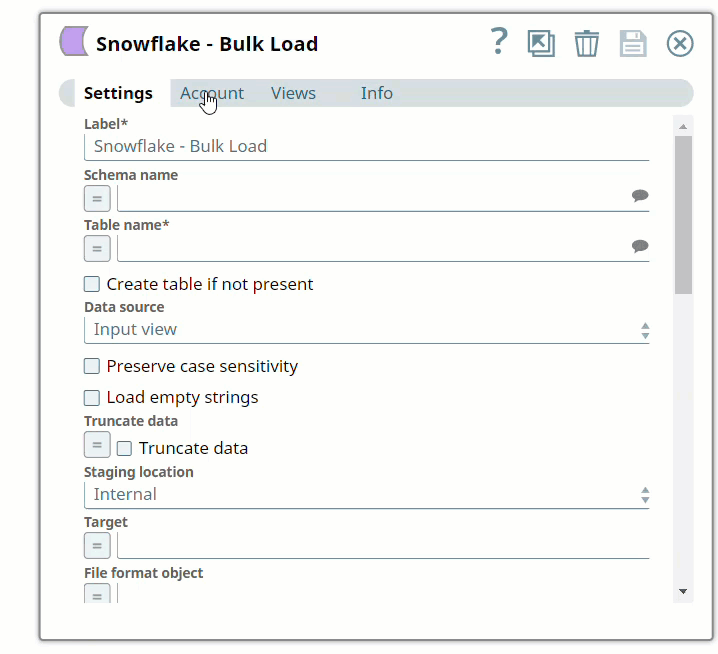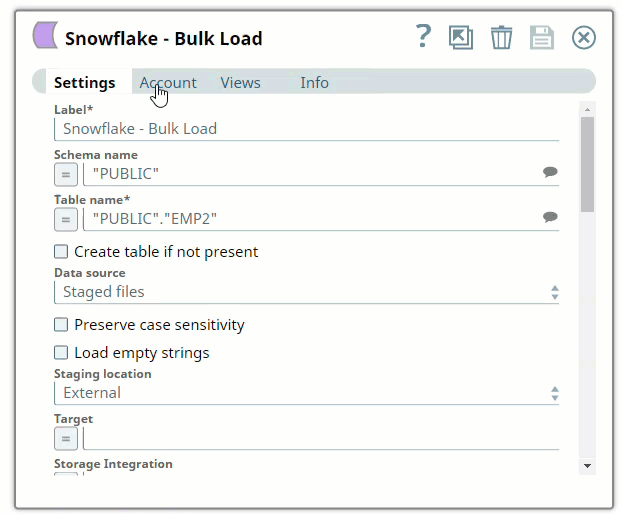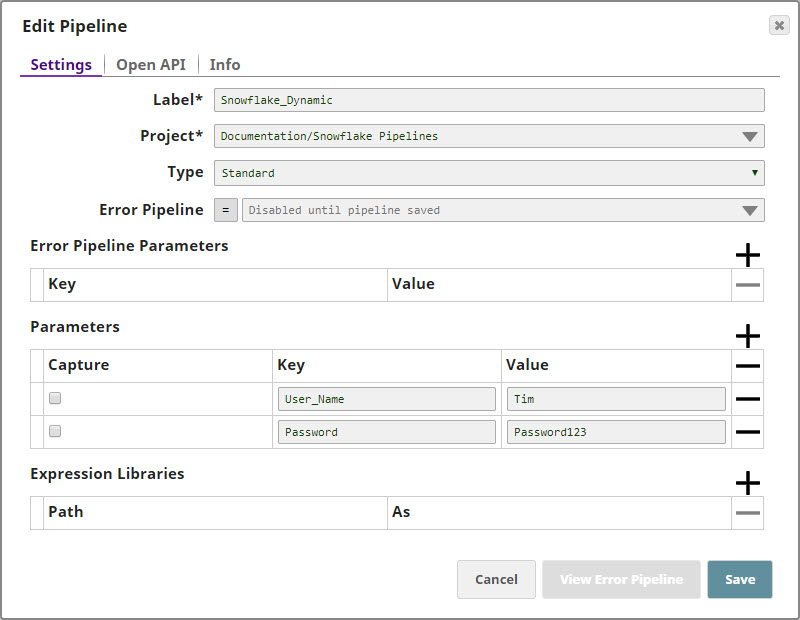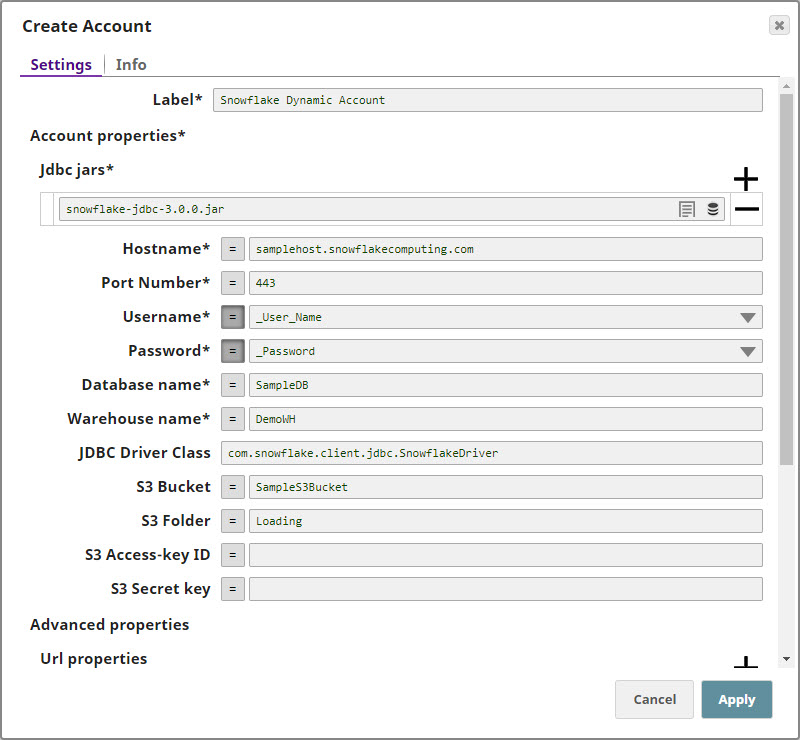In this article
| Table of Contents | ||||||
|---|---|---|---|---|---|---|
|
Overview
You can create Snowflake accounts to connect to data sources that you want to use in your Pipelines.
Articles in this section
| Panel | ||
|---|---|---|
| ||
|
Snap-Account Compatibility
In this article
| Table of Contents | ||||||
|---|---|---|---|---|---|---|
|
In this section
| Child pages (Children Display) |
|---|
Overview
You must create Snowflake accounts to connect to data sources that you want to use in your pipelines. You can configure your Snowflake accounts in SnapLogic using either the Designer or the Manager.
The Snowflake Snap Pack is now bundled with the default Snowflake JDBC JAR v3.14.
As of November 1, 2023, Snowflake instances hosted on Google Cloud must use Snowflake JDBC JARs v3.13.25 or higher. If you are using the default drivers bundled with Snowflake or ELT Snaps, your pipelines are not affected. If your Snowflake instances hosted on Google Cloud use older JARs, you must update the client drivers. Learn more.
Snap-Account Compatibility
✔ | ✔ | ✔ | ✔ | ✔ | ✔ | ✔ | |
✔ | ✔ | ✔ | ✔ | ✔ | ✔ | ✔ | |
✔ | ✔ | ✔ | ✔ | ✔ | ✔ | ✔ | |
✔ | ✔ | ✔ | ✔ | ✔ | ✔ | ✔ | |
✔ | ✔ | ✔ | ✔ | ✔ | ✔ | ✔ | |
✔ | ✔ | ✔ | ✔ | ✔ | ✔ | ✔ | |
✔ | ✔ | ✔ | ✔ | ✔ | ✔ | ✔ | |
✔ | ✔ | ✔ | ✔ | ✔ | ✔ | ✔ | |
✔ | ✔ | ✔ | ✔ | ✔ | ✔ | ✔ | |
✔ | ✔ | ✔ | ✔ | ✔ | ✔ | ✔ | |
✔ | ✔ | ✔ | ✔ | ✔ | ✔ | ✔ | |
✔ | ✔ | ✔ | ✔ | ✔ | ✔ | ✔ |
Configuring Snowflake Accounts
You can configure your Snowflake accounts in SnapLogic using either the Designer or Manager.
Using SnapLogic Designer
Drag a Snowflake Snap to the Canvas and click the Snap to open its settings. Click the Account tab. You can now either use an existing account or create a new one.
Selecting an existing account
SnapLogic organizes and displays all accounts to which you have access, sorting them by account type and location. To select an existing account:
Click the icon to view the accounts to which you have access and select the account that you want to use.
Click to save the Snap settings.
Creating an account
Click Add
Account in
the Account
Reference dialog.
Select
the Location
in which you want to create the account, select the account type, and
click Continue.
The Add Account
dialog associated with the account type appears.
Enter the required account details. For detailed guidance on how to provide information
children
associated with each account type, refer to Snowflake Azure Database Account, Snowflake Google Storage Database Account, Snowflake S3 Database Account, Snowflake S3 Dynamic Account, Snowflake Azure OAuth2 Account, Snowflake Google Storage OAuth2 Account, and Snowflake S3 OAuth2 Account
Click Validate to verify the account, if the account type supports validation.
Click Apply to complete configuring the Snowflake account.
| Info |
|---|
Enter additional information on this account in |
the Notes |
field of the Info tab. This will |
help you–and other users–understand the purpose of the account, especially if there are multiple accounts of the same type. |
Click Validate to verify the account, if the account type supports validation.
Click Apply to complete configuring the Snowflake account.
Configuring Snowflake Accounts Using SnapLogic Manager
Use Manager
to create accounts without associating them immediately with Pipelines.
Accounts in SnapLogic are associated with projects. You can use accounts created in other projects only if you have at least Read access to them.
In the left pane, browse to the project in which you want to create the account and
click
 > Account > Snowflake, followed by the appropriate account type. The Create Account dialog associated with the selected account type is displayed.
> Account > Snowflake, followed by the appropriate account type. The Create Account dialog associated with the selected account type is displayed.
Repeat the steps numbered 3 through 5 in
section.
Avoid updating account credentials while Pipelines using that account are executing.
Doing so may lead to unexpected results, including
your account getting locked.
Account Encryption
Standard Encryption | If you are using Standard Encryption, the High sensitivity settings under Enhanced Encryption are followed. | |
|---|---|---|
Enhanced Encryption | If you have the Enhanced Account Encryption feature, the following describes which fields are encrypted for each sensitivity level selected per each account. Account
| |
Using Pipeline Parameters in Account Configuration
You can use Pipeline parameters when configuring dynamic Snowflake accounts. See Pipeline Parameters in Pipeline Properties for more information.
Example
Define the following two Pipeline parameters in the Pipeline with which you want to associate the new account:
User_name
Pass_word
You will use these values in the Dynamic account.
In the Snowflake pipeline, create a Snowflake Dynamic Account
Set the expression toggle on for both Username and Password
Set Username to _user_name and Password to _password
Click Apply and fill the Snap Settings for the desired function.
| Info |
|---|
You cannot Validate an account connection when creating a Snowflake Dynamic Account, because the account properties of a dynamic account are provided dynamically as Pipeline parameters. |
Apply the changes. Your dynamic account is now configured; and your username and password details should change as you update them in your Pipeline parameters.
Snap Pack History
| Expand | ||||||||||
|---|---|---|---|---|---|---|---|---|---|---|
|






